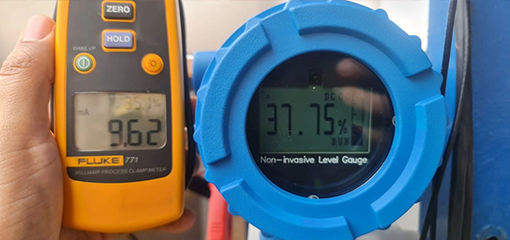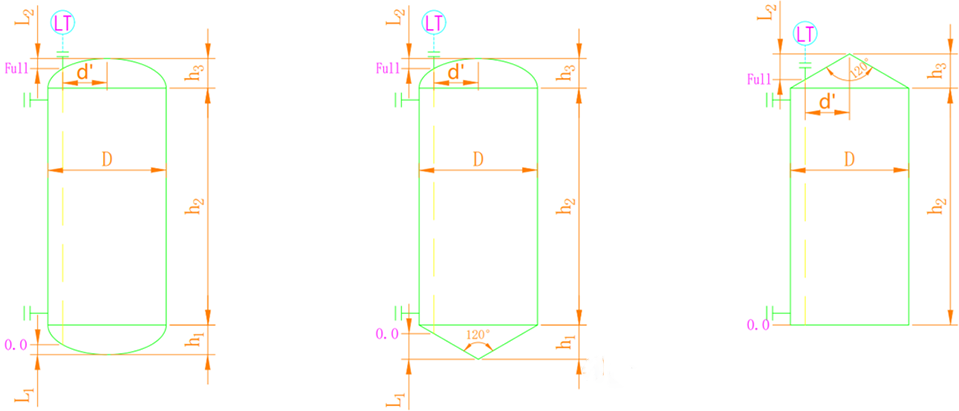Ultrasonic level sensor is a digital level gauge controlled by a microprocessor. During measurement, ultrasonic pulses are emitted by the sensor (transducer), and the sound waves are reflected by the liquid surface and received by the same sensor or ultrasonic receiver. They are converted into electrical signals through piezoelectric crystals or magnetostrictive devices, and the distance from the sensor to the surface of the measured liquid is calculated by the time between the emission and reception of the sound waves. Due to the use of non-contact measurement, the measured medium is almost unlimited, and it can be widely used to measure the height of various liquid materials.
Features of SKE non-invasive ultrasonic level gauges:
1. It has strong anti-interference ability. The upper and lower limit nodes and online output adjustment can be set arbitrarily, and it has a field display. You can choose analog quantity, switch quantity and RS485 output, which is convenient for interface with related facilities.
2. It adopts polypropylene or aluminum alloy waterproof shell. The shell is small but quite strong, with excellent chemical resistance. For inorganic compounds, no matter acid, alkali, or salt solution, except for strong oxidizing materials, it has almost no destructive effect on it. It is insoluble in almost all solvents at room temperature. It can be used on media such as alkanes, hydrocarbons, alcohols, phenols, aldehydes, and ketones.
3. It is light in weight, does not scale, and does not pollute the medium.
4. It is non-toxic. It can be used for installation of pharmaceutical and food industry equipment, and maintenance is extremely convenient.
Ultrasonic level meter measurement principle and level measurement point:
Below, we'll take the ultrasonic non-invasive level gauge as an example to introduce the volume-related calculation corresponding to the real-time liquid level of the elliptical head and conical head installed on the cylinder of the storage tank.
The non-invasive ultrasonic level sensor installed on the top, during the measurement, the ultrasonic pulse is emitted by the sensor, and the sound wave is reflected by the liquid surface and received by the same sensor or ultrasonic receiver, and converted into an electrical signal through a piezoelectric crystal or magnetostrictive device, and the distance from the sensor to the measured liquid surface is calculated by the time between the emission and reception of the sound wave. As shown in the figure above, the lowest liquid level (0 level) measured is at the bottom head of the tank directly below the level gauge, and the highest liquid level measured is at the ultrasonic emission point.
Problems encountered in actual working conditions and solutions:
Problem 1: The temperature in the on-site water pool or tank is high, which affects the measurement of the ultrasonic level gauge. Fault phenomenon: When the water surface is close to the probe, it can be measured, but when the water surface is far away from the probe, it cannot be measured. When the water temperature is low, the ultrasonic level transmitter measures normally, and when the water temperature is high, the non-invasive ultrasonic level gauge cannot measure.
Reason: Liquid media generally do not produce steam and mist below 30-40℃. Above this temperature, steam or mist is easy to be generated. The ultrasonic wave emitted by the ultrasonic level gauge will decay once through the steam during the transmission process and reflect back from the liquid surface. When it needs to decay again, the ultrasonic signal returned to the probe is very weak, so it cannot be measured. Moreover, in this environment, water droplets are prone to appear on the non-invasive ultrasonic level gauge probe, which will hinder the transmission and reception of ultrasonic waves.
Solution:
1. Increase the measuring range. The actual height of the tank is 3 meters. A 6-meter to 9-meter ultrasonic level gauge should be selected. This can reduce or weaken the impact of steam or fog on the measurement.
2. The probe should be made of polytetrafluoroethylene or polyvinylidene fluoride and be physically sealed so that water droplets are not easily condensed on the emitting surface of the probe. Water droplets are more likely to condense on the emitting surface of other materials.
Problem 2: There is electromagnetic interference on site.
Fault phenomenon: The ultrasonic level sensor data jumps irregularly, or there is no signal at all.
Cause: There will be many motors, frequency converters and electric welding on the industrial site, which will affect the measurement of the ultrasonic level sensor. Electromagnetic interference will drown out the echo signal received by the probe.
Solution:
1. The non-invasive ultrasonic level gauge must be reliably grounded. After grounding, some interference on the circuit board will escape through the ground wire. And this ground wire must be grounded separately and cannot share a ground wire with other equipment.
2. The power supply cannot be the same as the frequency converter and motor, nor can it be directly drawn from the power supply of the power system.
3. The installation site should be away from the frequency converter, frequency conversion motor, and high-power electrical equipment. If it is impossible to stay away, a metal instrument box should be installed outside the level gauge for isolation and shielding, and the instrument box should also be grounded.
Problem 3: Entering the blind area
Fault phenomenon: Full scale or arbitrary data appears.
Cause: The ultrasonic level sensor has a blind area, generally within a range of 5 meters, and the blind area is 0.3-0.4 meters. 0.4-0.5 meters within a range of 10 meters. After the ultrasonic wave enters the blind area, an arbitrary value will appear and it will not work properly.
Solution:
1. The height of the blind area must be considered during installation. After installation, the distance between the probe and the highest water level must be greater than the blind area.
The above reasons may cause the ultrasonic level gauge to work abnormally, so when purchasing an ultrasonic level gauge, be sure to tell the on-site working conditions to experienced customer service to help you choose the model and recommend how to install it. Ensure that the non-invasive ultrasonic level gauge works properly.

 CN
CN


